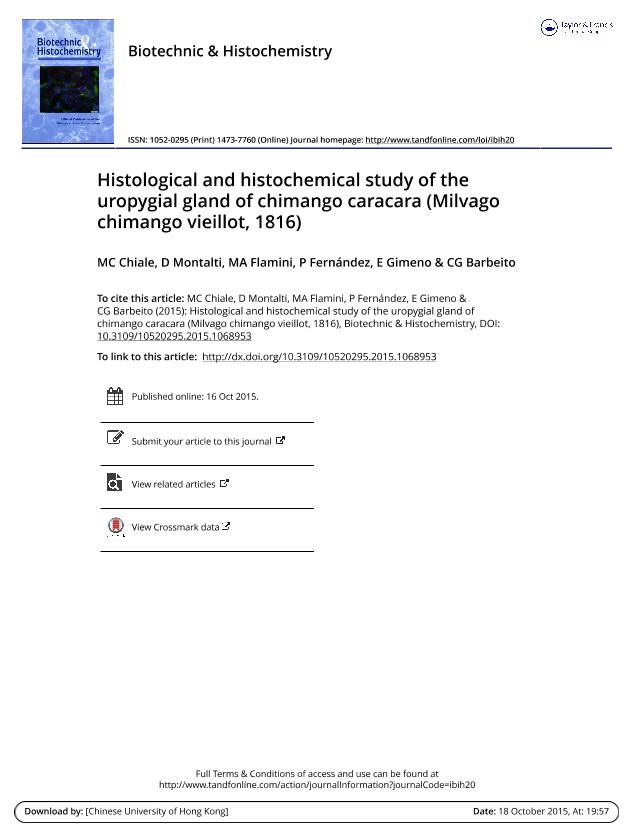Artículo
Histological and histochemical study of the uropygial gland of chimango caracara (Milvago chimango vieillot, 1816)
Chiale, Maria Cecilia ; Montalti, Diego
; Montalti, Diego ; Flamini, Mirta Alicia; Fernández, P.; Gimeno, Eduardo Juan
; Flamini, Mirta Alicia; Fernández, P.; Gimeno, Eduardo Juan ; Barbeito, Claudio Gustavo
; Barbeito, Claudio Gustavo
 ; Montalti, Diego
; Montalti, Diego ; Flamini, Mirta Alicia; Fernández, P.; Gimeno, Eduardo Juan
; Flamini, Mirta Alicia; Fernández, P.; Gimeno, Eduardo Juan ; Barbeito, Claudio Gustavo
; Barbeito, Claudio Gustavo
Fecha de publicación:
01/2016
Editorial:
Informa Healthcare
Revista:
Biotechnic and Histochemistry
ISSN:
1052-0295
Idioma:
Inglés
Tipo de recurso:
Artículo publicado
Clasificación temática:
Resumen
The uropygial glands of birds are sebaceous organs that contribute to the water-repellent properties of the feather coat. We studied the histological and histochemical characteristics of the uropygial gland of chimango caracara using hematoxylin and eosin (H & E), Gomorís trichrome, orcein, Gomorís reticulin, periodic acid-Schiff (PAS), Alcian blue (AB) and a variety of lectins. The gland is composed of two lobes and a papilla with 20 downy feathers. It is surrounded by a capsule of dense connective tissue that contains elastic, reticular and smooth muscle fibers. The papilla is delicate and has two excretory ducts. The gland mass relative to body mass was 0.143%. Both adenomer cells and their secretions were stained with Sudan IV, PAS and AB, and were positive for numerous lectins that indicated the presence of lipids and carbohydrates. Immunohistochemical techniques to detect PCNA confirmed cell proliferation in the basal stratum of the adenomer cells. The lipids and glycoconjugates secreted by the uropygial gland serve numerous functions including protection against microorganisms.
Palabras clave:
Caracaras
,
Falconiformes
,
Glycoconjugates
,
Histology
,
Preen Gland
Archivos asociados
Licencia
Identificadores
Colecciones
Articulos(CCT - LA PLATA)
Articulos de CTRO.CIENTIFICO TECNOL.CONICET - LA PLATA
Articulos de CTRO.CIENTIFICO TECNOL.CONICET - LA PLATA
Citación
Chiale, Maria Cecilia; Montalti, Diego; Flamini, Mirta Alicia; Fernández, P.; Gimeno, Eduardo Juan; et al.; Histological and histochemical study of the uropygial gland of chimango caracara (Milvago chimango vieillot, 1816); Informa Healthcare; Biotechnic and Histochemistry; 91; 1; 1-2016; 30-37
Compartir
Altmétricas



